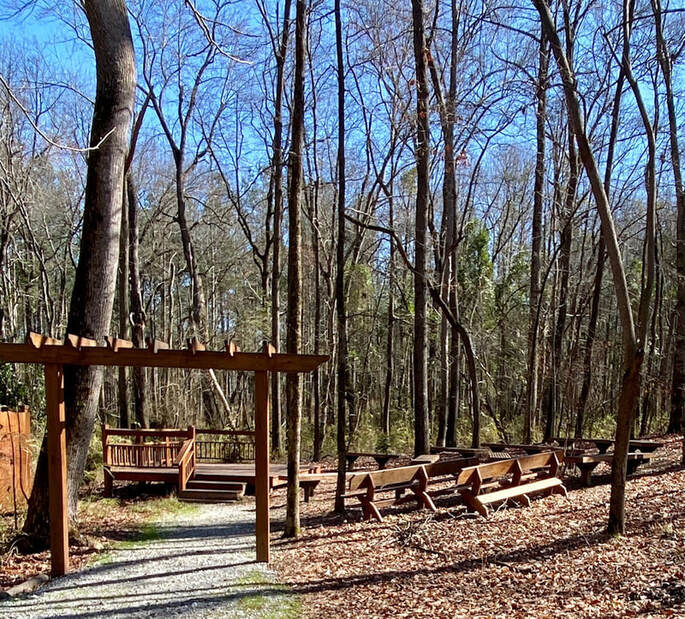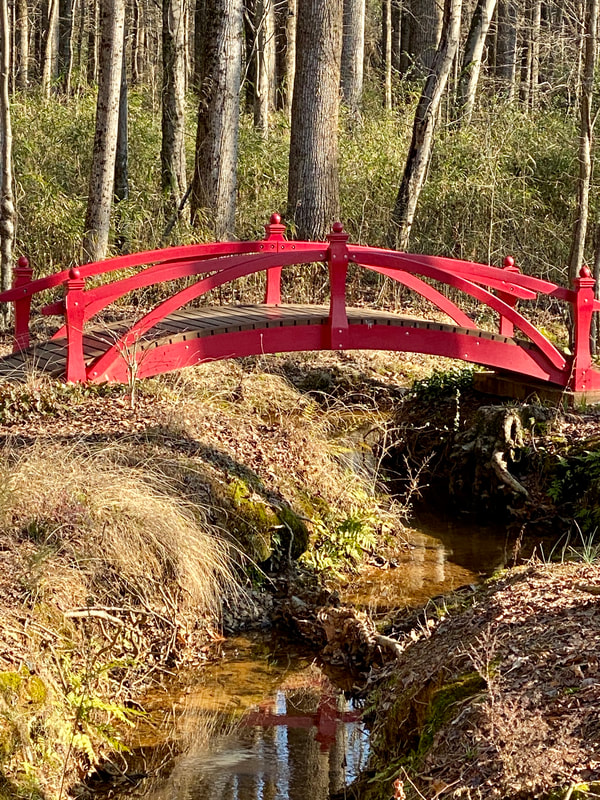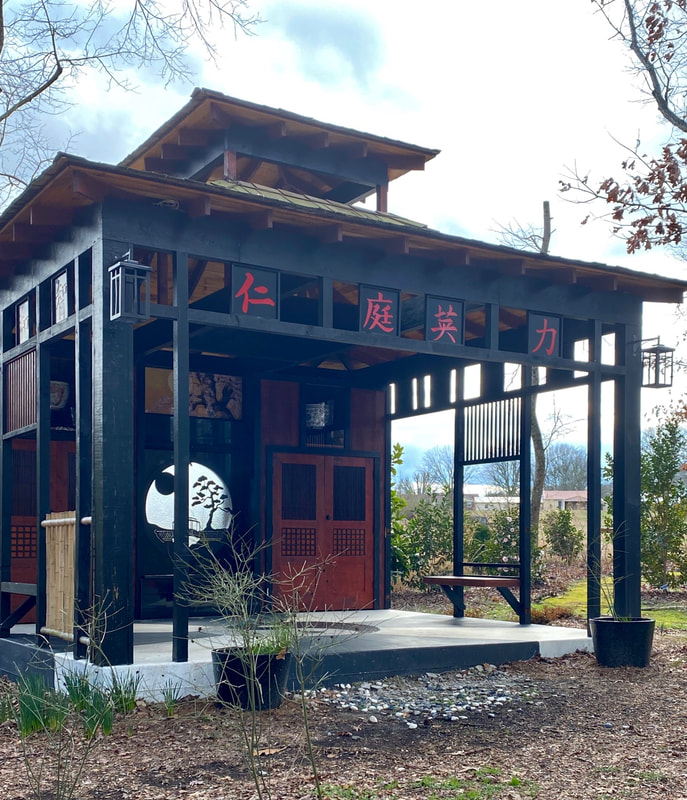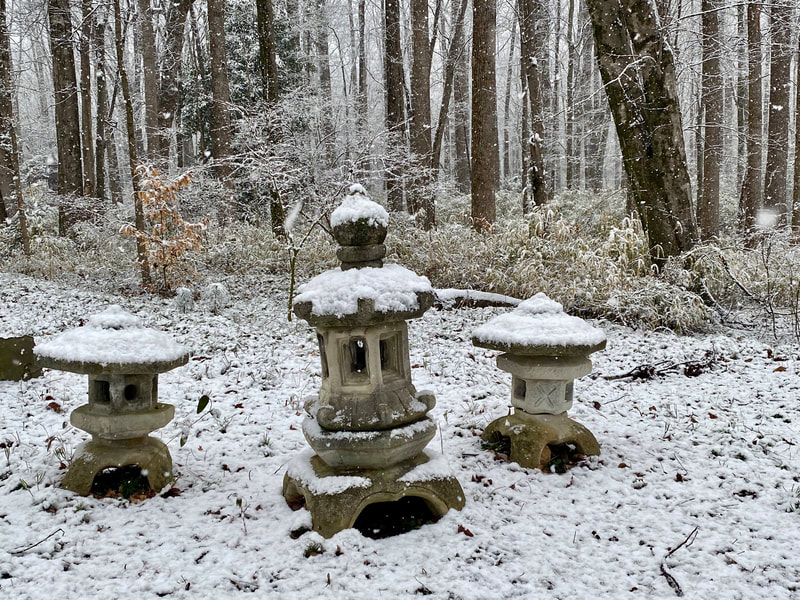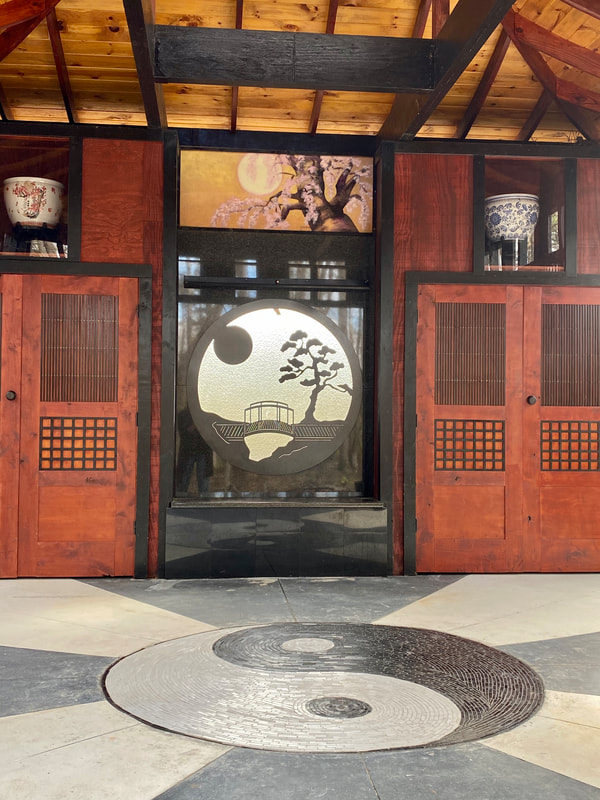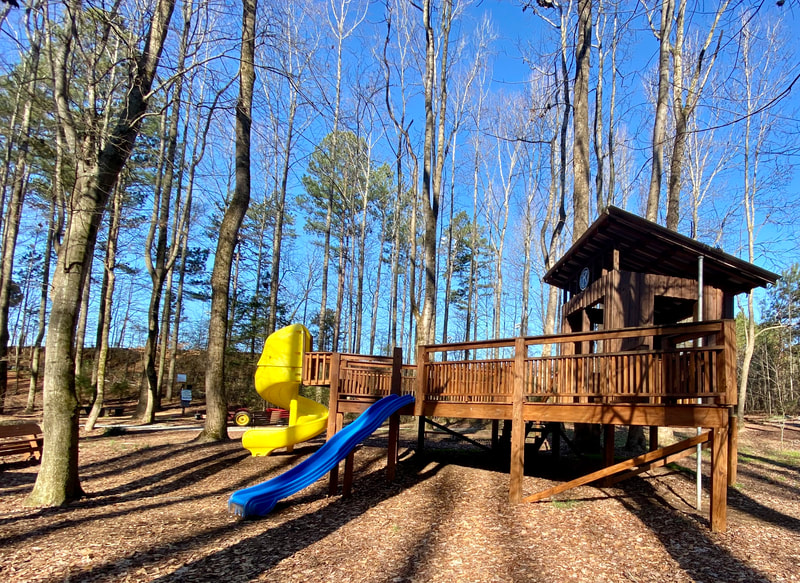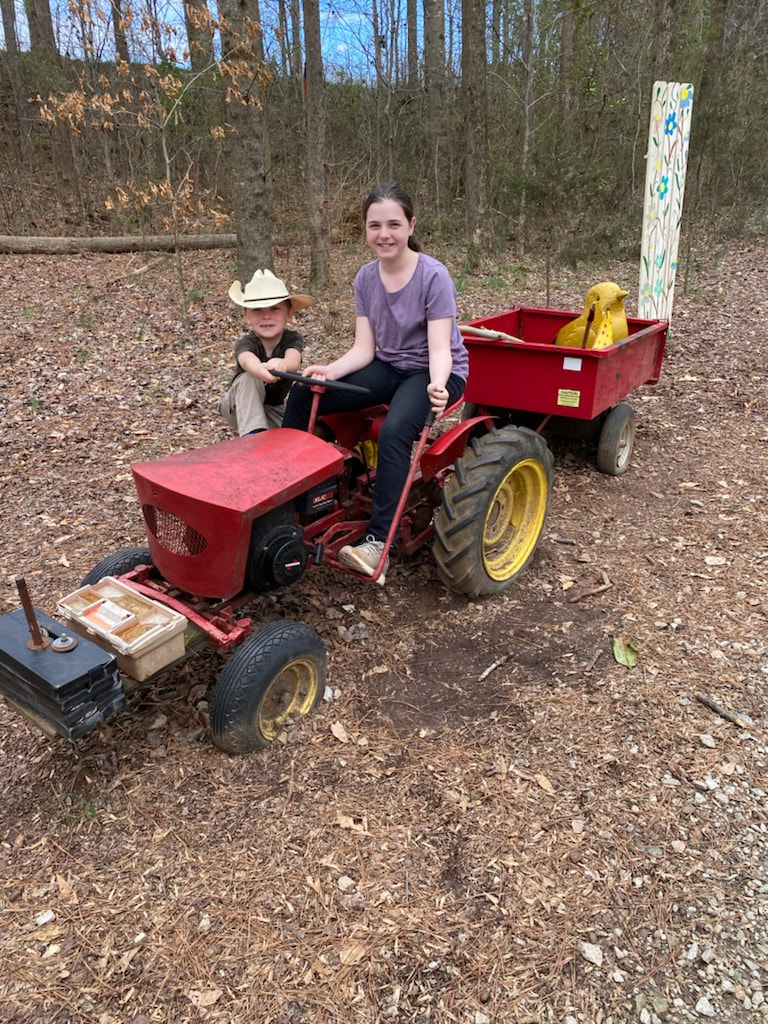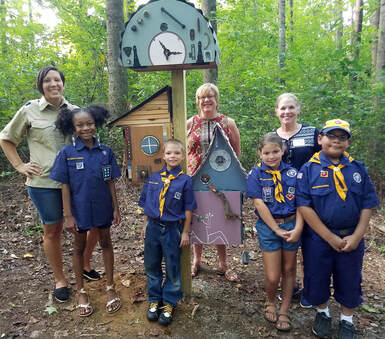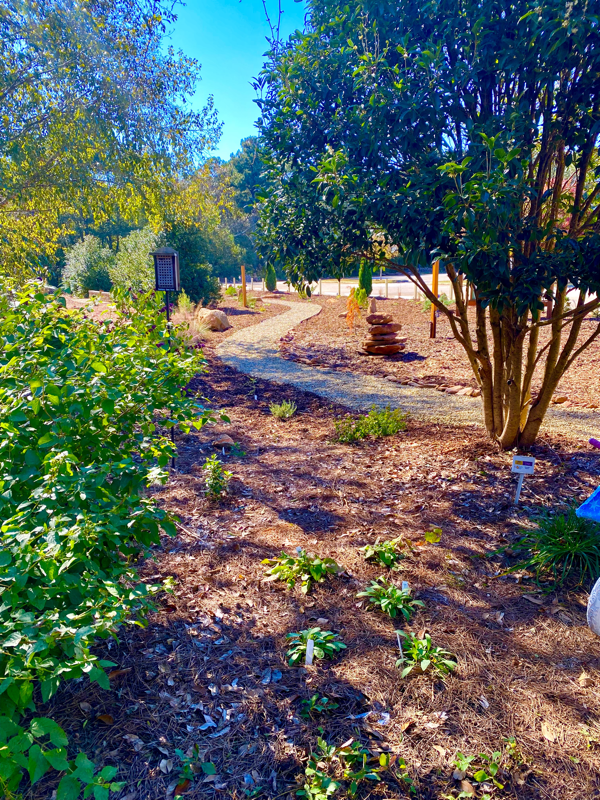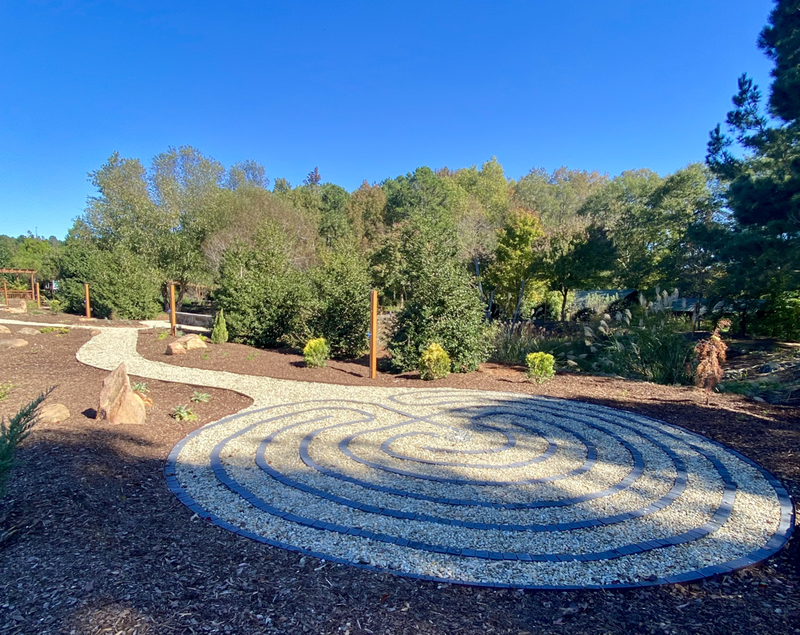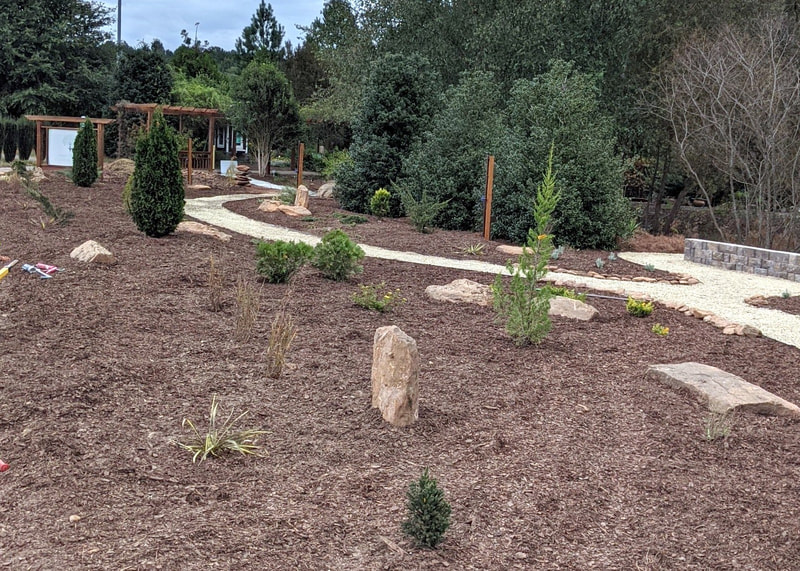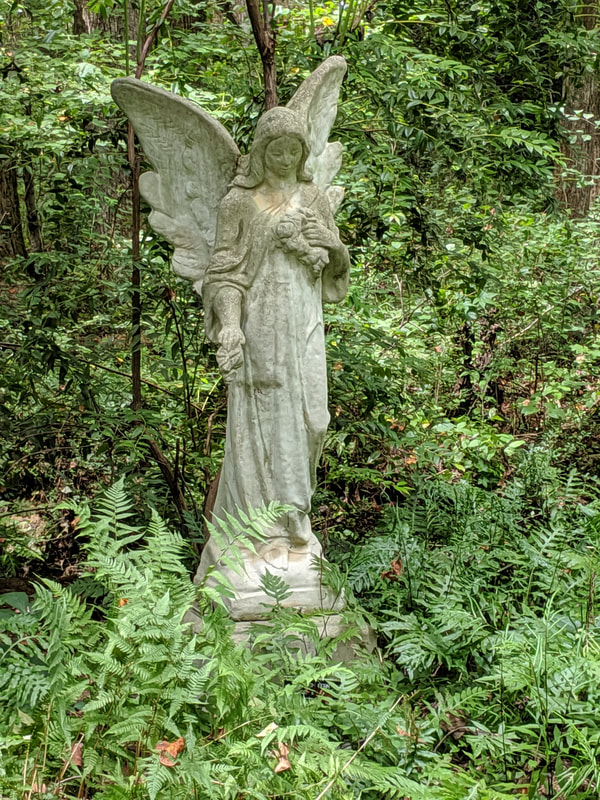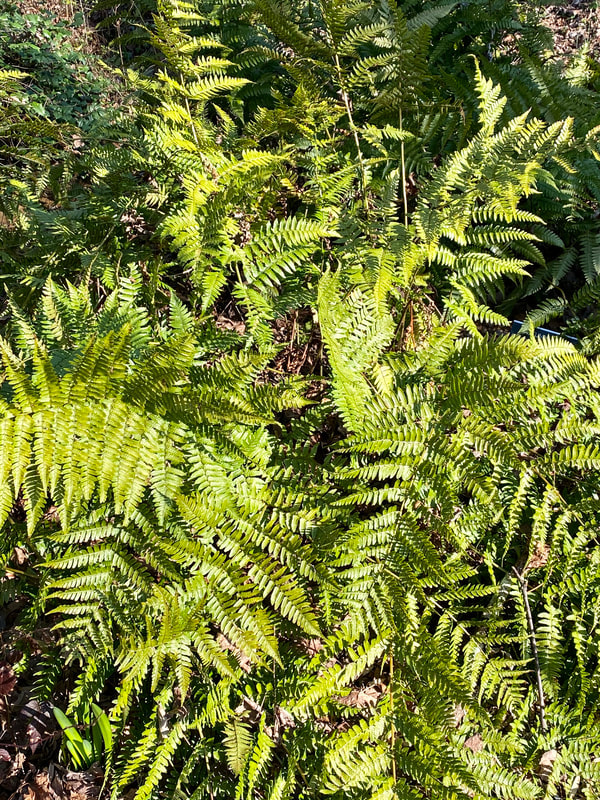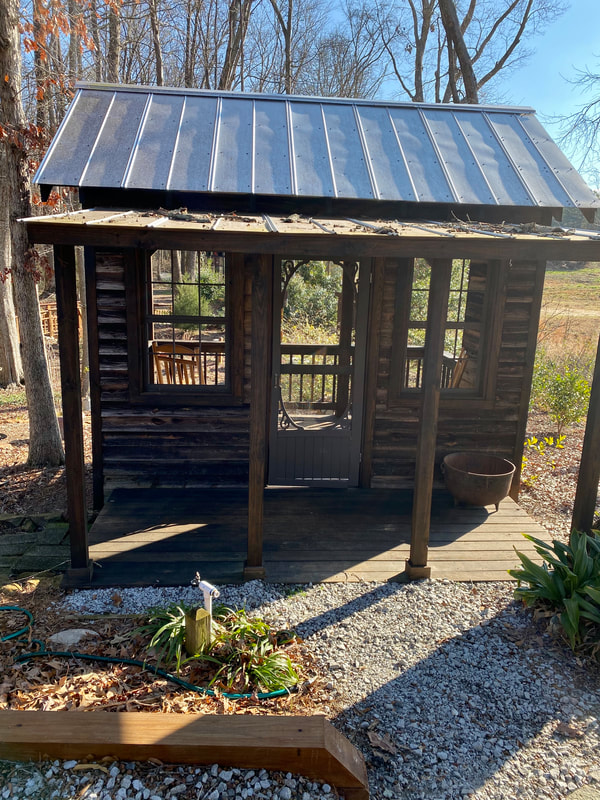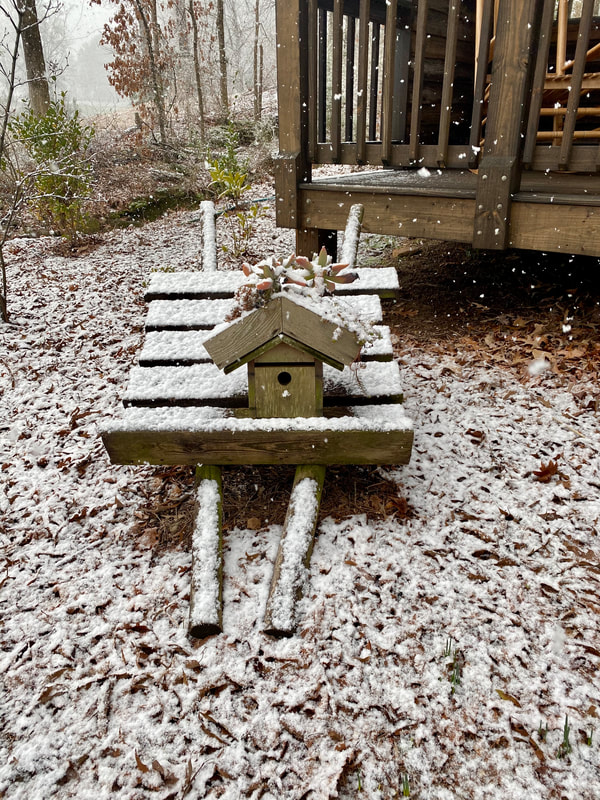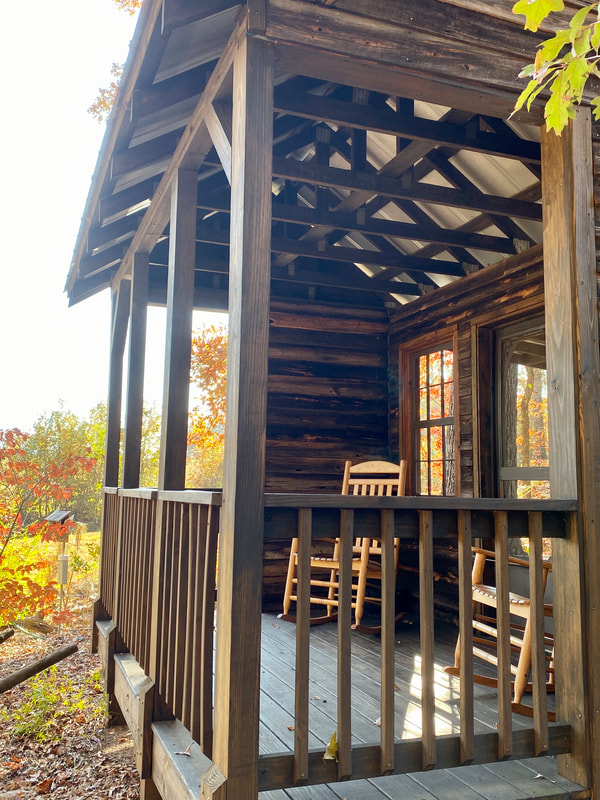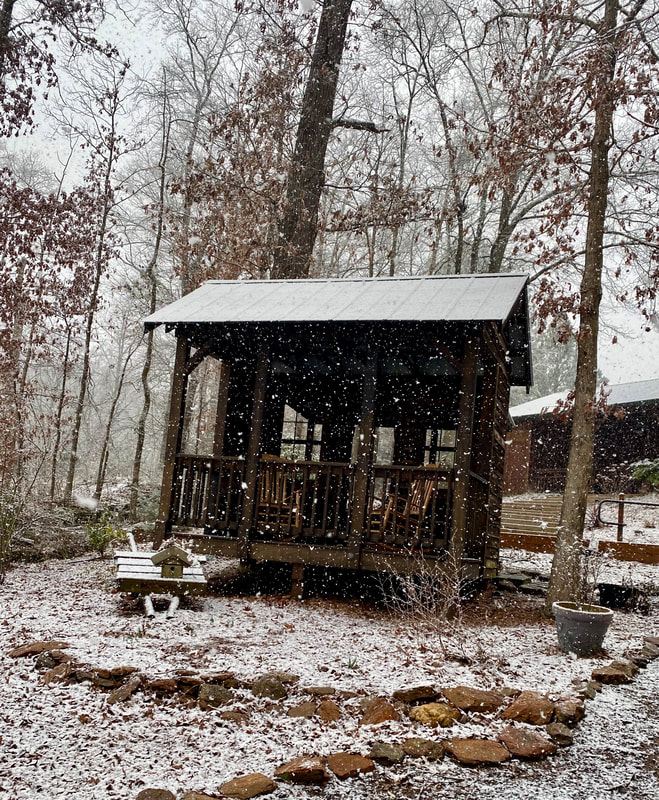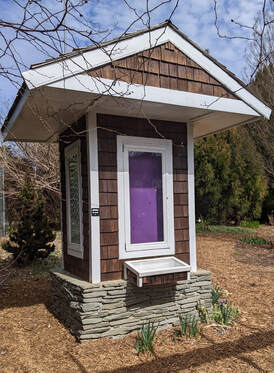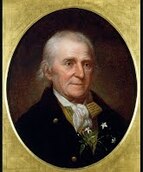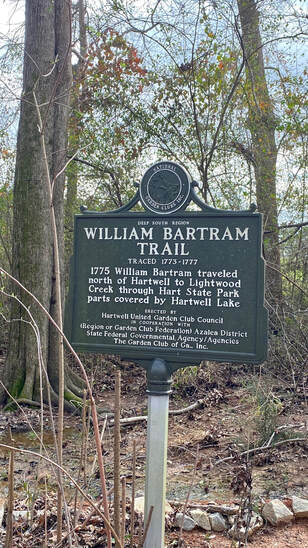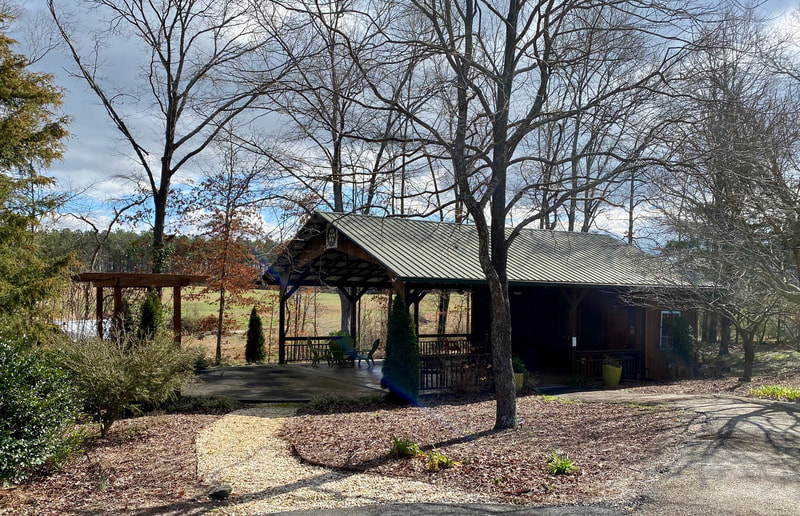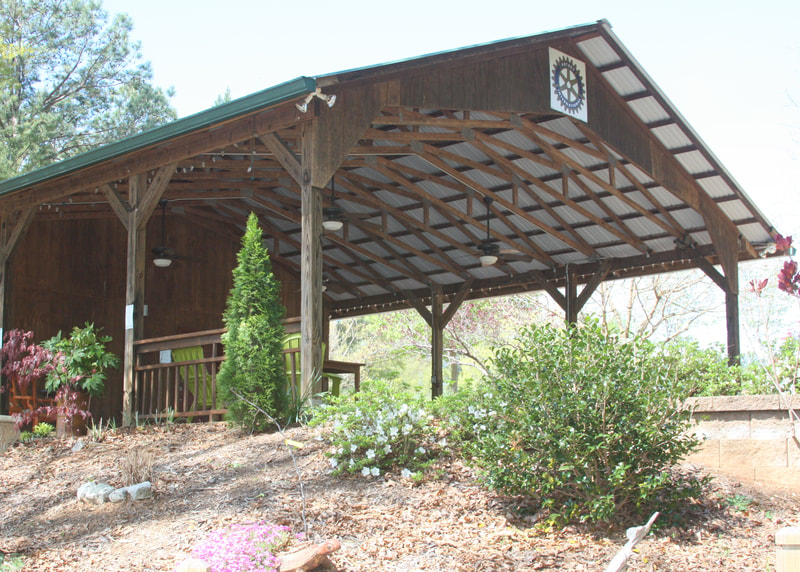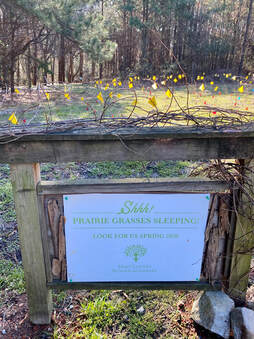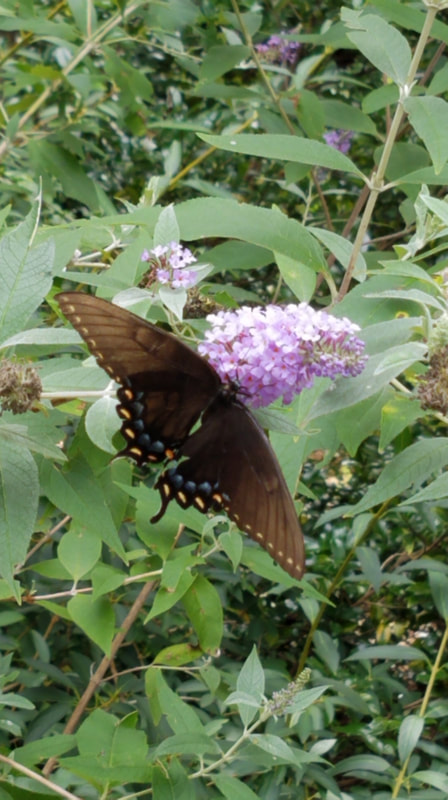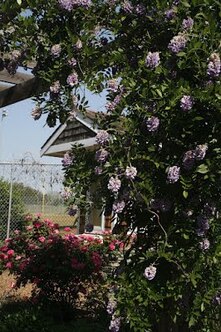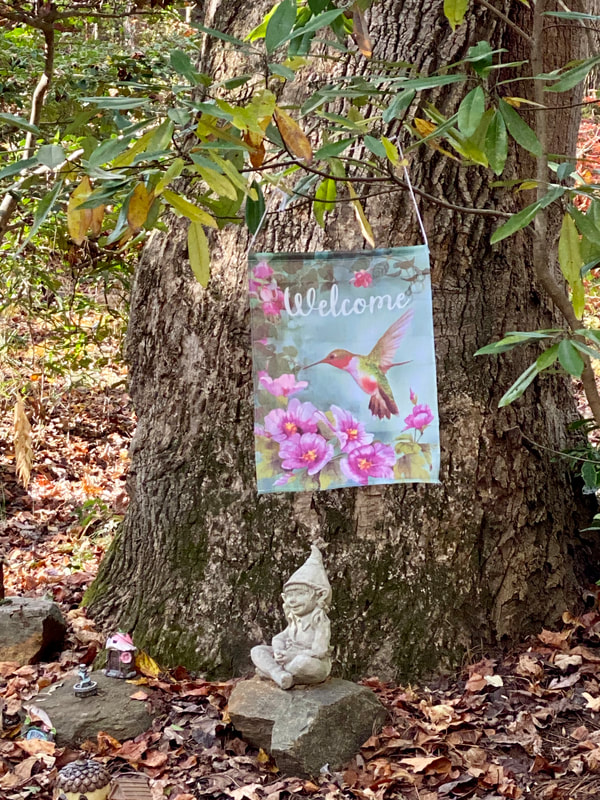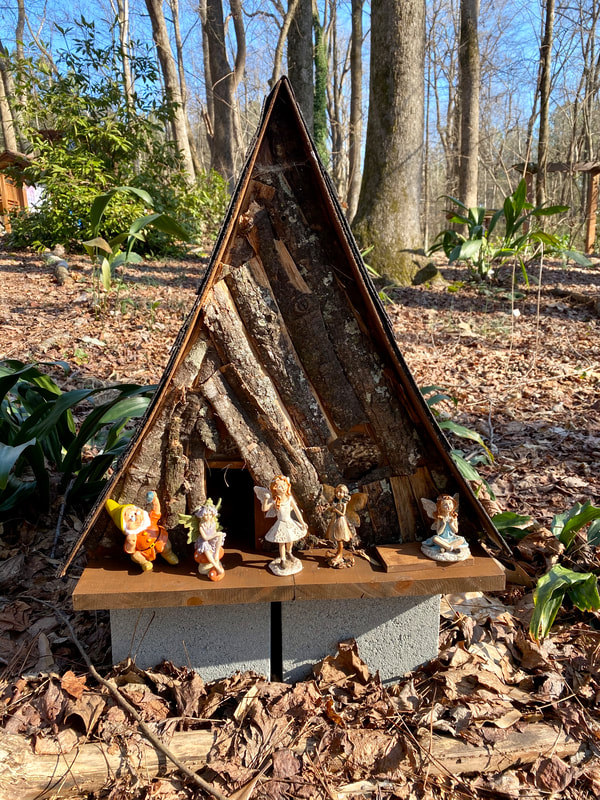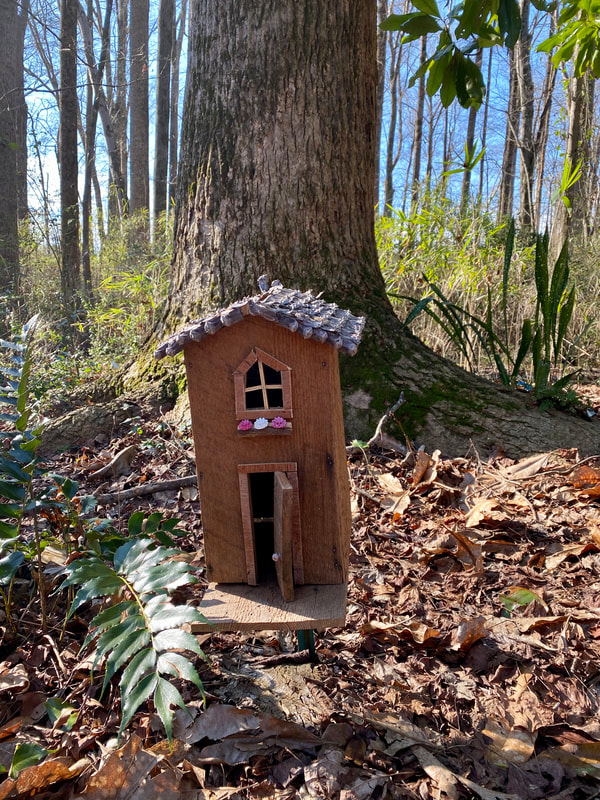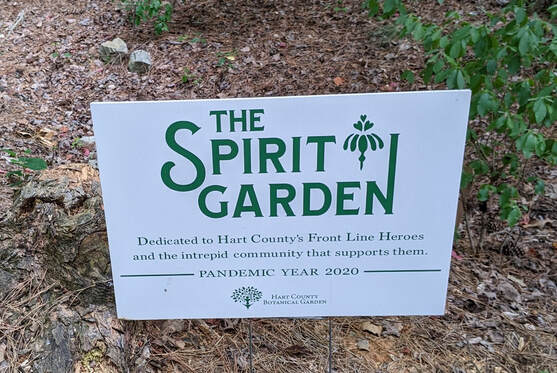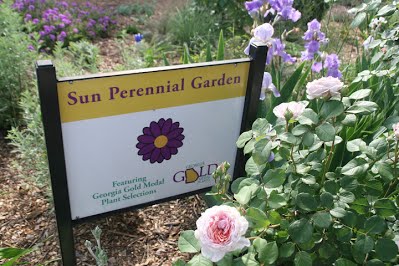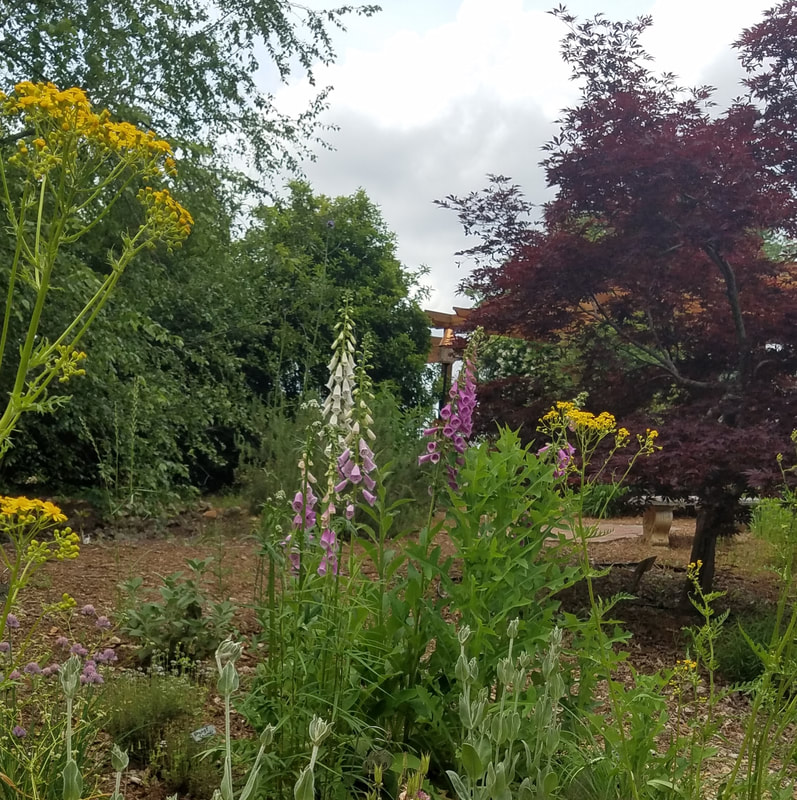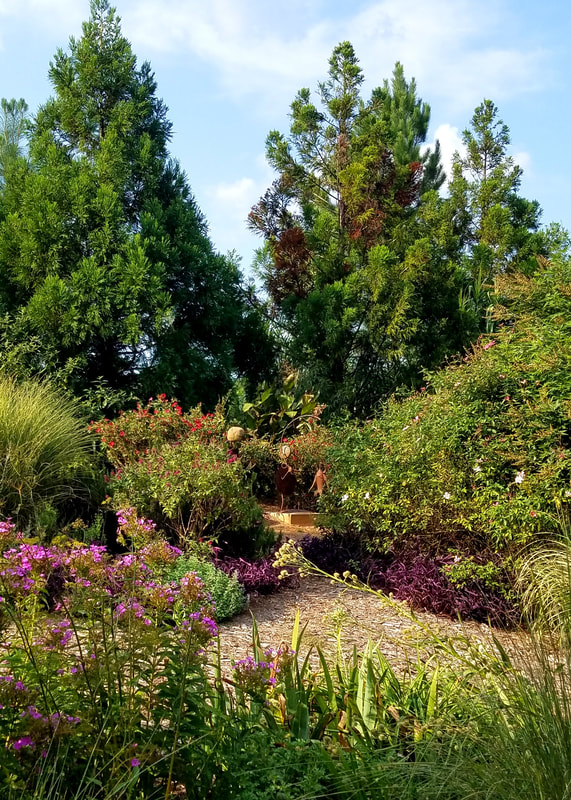Play the Video Below to take a "Virtual" Tour of the Gardens
Amphitheater
The Gardens can host many types of events in our Pavilion and Amphitheater areas.
Check out our Rental Page for more information.
CURATOR(S): Billy & Jean Kidd
Check out our Rental Page for more information.
CURATOR(S): Billy & Jean Kidd
Anne King Garden
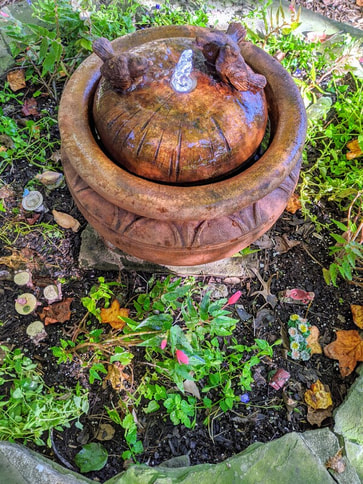
Anne King was a member of our first Master Gardener class in 1997. She proposed the idea of developing a botanical garden in Hart County that would be a place of beauty and education for the area citizens. Her vision became a reality in 2000 when work on the garden began. Anne worked for 31 years with the Hart County Extension Office and retired in 2004. She looked forward to having more time to dig in the Hart County Botanical dirt, but sadly, passed away in 2006.
Anne was a collector of plants, and Japanese maples and hellebores were among her favorites. Look for these special plants honoring her in the garden. She treasured all plants, especially 'passalong' plants and the connections with friends that they held. Many native perennials and shrubs are planted in the Anne King Garden so that something will be blooming almost year round. There are also many 'passalong' plants that were generously donated by Anne King's Master Gardener friends.
In developing this garden we hope to express our thanks to Anne for her vision and her unbridled spirit. We invite you to sit and relax while enjoying the peaceful beauty of the Anne King Garden.
CURATOR(S): Ed & Lorin Clark
Asian Woodland Garden
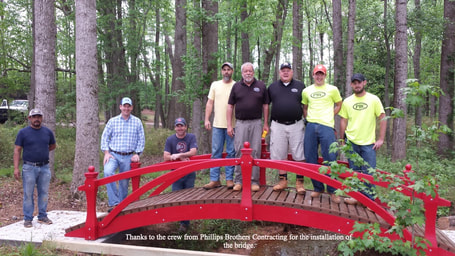
The Asian Woodland Garden, begun in 2016, features plants from Asia, mostly the Southeast region of that continent. The plants provide four seasons of interest and include many different cultivars of Camellia Japonica (i.e., originating in Japan.) Also featured is a collection of Japanese maples which display vibrant shades of red, orange and yellow in the fall. Japanese heavenly bamboo, azaleas and Chinese paper bush (Edgeworthia chrysanta) are also featured. Many of the Japanese Maples and camellias in the Asian Woodland Garden have been donated in memory of a loved one or to commemorate a special event.
This garden provides an example of plants from Asia which are great to use in local Zone 8 gardens. Many of them did not exist in the USA before plant explorers introduced them.
The focal point of the Asian garden is the Moon House, a large open structure that invites a variety of uses including contemplation, yoga, meditation, picnics, weddings and photography sessions. A red, Japanese-style bridge crosses the creek on the way up the path to the Moon House.
CURATOR(S): Robert Meaders
This garden provides an example of plants from Asia which are great to use in local Zone 8 gardens. Many of them did not exist in the USA before plant explorers introduced them.
The focal point of the Asian garden is the Moon House, a large open structure that invites a variety of uses including contemplation, yoga, meditation, picnics, weddings and photography sessions. A red, Japanese-style bridge crosses the creek on the way up the path to the Moon House.
CURATOR(S): Robert Meaders
Bog Garden
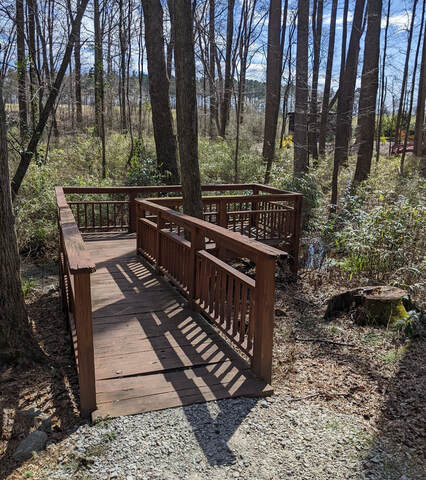
The Bog Garden is located across from the Rhododendron Garden along the path to the Children’s Garden. It is part of the original landscape and, with the exception of the observation deck, has remained unaltered. It is the result of a spring which intersects a flowing body of groundwater at or below the local water table.
The Bog spring is rather small in area and, due to silt infiltration, it is relatively shallow. It does have a slow consistent water flow year-round. In the 1930s and 40s, the family who farmed the area where the county ball fields are currently located got drinking water from the spring and
hauled it up the hill to their house.
Plants in the area include switch cane and dog hobble. Both are natives that grow along stream banks.
CURATOR(S): Kathy Bryant
The Bog spring is rather small in area and, due to silt infiltration, it is relatively shallow. It does have a slow consistent water flow year-round. In the 1930s and 40s, the family who farmed the area where the county ball fields are currently located got drinking water from the spring and
hauled it up the hill to their house.
Plants in the area include switch cane and dog hobble. Both are natives that grow along stream banks.
CURATOR(S): Kathy Bryant
Children's Garden
The goal of the Children's Garden is to provide an interesting and educational place for children and parents to visit and enjoy. Here they can learn about nature by observing insects, the soil, ground covers, snakes, and plants that don't look like animals, but have animal names.
Bring the kids to enjoy and learn in our Children's Garden while also giving them the opportunity to play and be physically active. There are several picnic tables to use, and the picket fences painted by the Hartwell Service League add whimsy and color to the garden.
Don't miss the nearby Free Little Library filled with books to enjoy during your stay and sit and play a game of checkers!
CURATOR(S): Ed & Lorin Clark, Pam Gordon
Bring the kids to enjoy and learn in our Children's Garden while also giving them the opportunity to play and be physically active. There are several picnic tables to use, and the picket fences painted by the Hartwell Service League add whimsy and color to the garden.
Don't miss the nearby Free Little Library filled with books to enjoy during your stay and sit and play a game of checkers!
CURATOR(S): Ed & Lorin Clark, Pam Gordon
Conifer Garden
The most recent addition to the Garden, the Conifer Walk is the result of a generous offer from Piccadilly Farm in Bishop, GA to donate a variety of native conifers. Located at the entrance of the Garden, it was completed in late 2021. Features include large indigenous boulders, a 20’ stone seating wall offering a view of the Garden below, a 14’ kinetic wind sculpture and a classic stone labyrinth.
Twenty-eight varieties of smaller scale conifers suitable for home landscapes are exhibited, along with companion plantings. These selections were grown locally and are suited to our specific climate. Most conifers are both evergreen and drought tolerant, rarely require pruning or fertilization and so, suit busy lifestyles. In lieu of flowering, the array of textures, form and color displayed by this plant classification can be enjoyed.
CURATOR(S): Gretchen Torrance
Twenty-eight varieties of smaller scale conifers suitable for home landscapes are exhibited, along with companion plantings. These selections were grown locally and are suited to our specific climate. Most conifers are both evergreen and drought tolerant, rarely require pruning or fertilization and so, suit busy lifestyles. In lieu of flowering, the array of textures, form and color displayed by this plant classification can be enjoyed.
CURATOR(S): Gretchen Torrance
Fern Garden
The Fern Garden, located at the back of the garden across from the amphitheater, was planted in two stages, Site A in 2008, Site B in 2010; the sites are separated by a stream and foot bridge. The Fern Garden features many varieties, including East Indian holly ferns, peacock moss ferns, Tokyo wood ferns, ostrich ferns, Christmas ferns, netted chain ferns, Autumn ferns and cinnamon ferns.
In the spring of 2021, bamboo fern (Shishi), tongue fern (Hagoroma Nishiki), ribbon fern (Korean Petticoat), lady fern (Lady in Red), maidenhair fern (Kunth’s Maiden Fern), male fern (Cristata the King), male fern (Crispa), river fern (Weekend at Boerne) and varieties of Mexican male fern and Southern wood fern were planted. A goal is to add new species of ferns to the garden each spring. Enhancing the ferns are Lenten rose, oxalis, sweet shrubs, Japanese maple, buckeye plants, snow drops and Kousa dogwoods. There is also a bog area under the small foot bridge; it hosts two varieties of large woodland iris that bloom each spring. A five-foot angel statue graces this garden, along with a wrought iron bench dedicated to Mimi Payne, the original Fern Garden curator.
CURATOR(S): Kathy Bryant
In the spring of 2021, bamboo fern (Shishi), tongue fern (Hagoroma Nishiki), ribbon fern (Korean Petticoat), lady fern (Lady in Red), maidenhair fern (Kunth’s Maiden Fern), male fern (Cristata the King), male fern (Crispa), river fern (Weekend at Boerne) and varieties of Mexican male fern and Southern wood fern were planted. A goal is to add new species of ferns to the garden each spring. Enhancing the ferns are Lenten rose, oxalis, sweet shrubs, Japanese maple, buckeye plants, snow drops and Kousa dogwoods. There is also a bog area under the small foot bridge; it hosts two varieties of large woodland iris that bloom each spring. A five-foot angel statue graces this garden, along with a wrought iron bench dedicated to Mimi Payne, the original Fern Garden curator.
CURATOR(S): Kathy Bryant
Heritage Garden and Bird Sanctuary
Created in 2017, the Heritage Garden is located below the pavilion, next to the Anne King Garden. The focus in this garden is the word “Heritage.” It is a step back in time to a Southern grandmother’s back yard. Trees, shrubs and flowers such as flowering quince, gardenia, hydrangea, daffodils, dogwood and crabapple remind us of days gone by when yards consisted of plants that grew on their own or were shared by neighbors and relatives. These plants were treasured as friends of the family. Many of the plants in the Heritage Garden came from old gardens and were donated.
Mamaw’s House is a small replica of the simple farm homes in Hart County. Built with 100-year-old siding, a tin roof and a slamming screen door, the back porch is the key feature. The rocking chairs provide a place to share a piece of the past and remember times gone by. The view from Mamaw’s porch offers metal chickens pecking in the dirt near a path leading to an authentic outhouse with a white automobile tire “planter.”
The Heritage Garden is a Certified Wildlife Sanctuary with the focus on birds. Located just off the back porch, a feeding station offers sunflower seeds, suet and peanuts for a variety of birds year-round. A purple martin house towers over the adjacent creek; bluebird and Carolina wren nesting boxes are scattered about. A bird bath offers water for drinking and bathing. There is a chart identifying the birds on Mamaw’s porch.
CURATOR(S): Woody Eakin and Luanne Burgess
Mamaw’s House is a small replica of the simple farm homes in Hart County. Built with 100-year-old siding, a tin roof and a slamming screen door, the back porch is the key feature. The rocking chairs provide a place to share a piece of the past and remember times gone by. The view from Mamaw’s porch offers metal chickens pecking in the dirt near a path leading to an authentic outhouse with a white automobile tire “planter.”
The Heritage Garden is a Certified Wildlife Sanctuary with the focus on birds. Located just off the back porch, a feeding station offers sunflower seeds, suet and peanuts for a variety of birds year-round. A purple martin house towers over the adjacent creek; bluebird and Carolina wren nesting boxes are scattered about. A bird bath offers water for drinking and bathing. There is a chart identifying the birds on Mamaw’s porch.
CURATOR(S): Woody Eakin and Luanne Burgess
Herb Garden
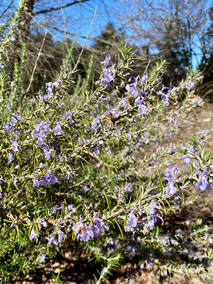
The Herb Garden, first planted in 2012, is located near the entrance of the botanical garden, on the right side of the path leading to the pavilion. You can also view it on the path to the Conifer Walk, near the Swale Garden. Its mission is to showcase the variety of herbs that are used for a myriad of purposes. With a mix of annual and perennial herbs, the garden provides a look at both sun-loving and shade- seeking herbs. Many herbs also serve as nature’s pollinators.
The herb garden is divided into four sections: culinary herbs, medicinal herbs, aromatic herbs and ornamental herbs. Some herbs fit into more than one category.
Culinary herbs are most likely the most familiar to garden lovers. Plants in this section include basil, chervil, chives, cilantro, dill, fennel, lemongrass, marjoram, mint, nasturtium, oregano, parsley, rosemary, sage and thyme. Either fresh or dried, these herbs are a welcome addition to any kitchen.
Medicinal herbs have a long history of use and many of our current medications have herbal beginnings.
Herbs can support the body’s natural healing processes. These herbs also offering calming properties and are used in products ranging from shampoo and body lotions to relaxing teas. Be on the lookout for ashwagandha, bilberry, chamomile, echinacea, foxglove and lavender.
The aromatic herbs include creeping rosemary, lemon verbena, artemisia, lemon scented geranium, lavender, wormwood, bee balm, pineapple sage, citrus marigolds and lemon balm. Blooming in summer months, these herbs add fragrance to the herb garden, and many are dual purpose, serving as culinary and medicinal herbs.
Ornamental herbs, such as prostate rosemary, catnip, silver thyme, berggarten sage, cardoon-cynara, garlic chives and verbena round out the garden with lovely blooms.
CURATOR(S): Amy Clark and Christine Rosenbloom
The herb garden is divided into four sections: culinary herbs, medicinal herbs, aromatic herbs and ornamental herbs. Some herbs fit into more than one category.
Culinary herbs are most likely the most familiar to garden lovers. Plants in this section include basil, chervil, chives, cilantro, dill, fennel, lemongrass, marjoram, mint, nasturtium, oregano, parsley, rosemary, sage and thyme. Either fresh or dried, these herbs are a welcome addition to any kitchen.
Medicinal herbs have a long history of use and many of our current medications have herbal beginnings.
Herbs can support the body’s natural healing processes. These herbs also offering calming properties and are used in products ranging from shampoo and body lotions to relaxing teas. Be on the lookout for ashwagandha, bilberry, chamomile, echinacea, foxglove and lavender.
The aromatic herbs include creeping rosemary, lemon verbena, artemisia, lemon scented geranium, lavender, wormwood, bee balm, pineapple sage, citrus marigolds and lemon balm. Blooming in summer months, these herbs add fragrance to the herb garden, and many are dual purpose, serving as culinary and medicinal herbs.
Ornamental herbs, such as prostate rosemary, catnip, silver thyme, berggarten sage, cardoon-cynara, garlic chives and verbena round out the garden with lovely blooms.
CURATOR(S): Amy Clark and Christine Rosenbloom
Native Woodland Garden
The Native Woodland, located between the Asian Garden and the Fern Garden, is an example of a deciduous Piedmont woodland. Part of the original 2004-2005 botanical garden, it includes plants that are indigenous to the Southeast. These plants co-evolved with the regional flora and fauna and are adapted to the climate, hydrology and soil conditions. They increase biodiversity by providing food, shelter and nesting material for birds, amphibians and other wildlife. To this end, no chemical fertilizers or pesticides are used.
The purpose of this garden is to highlight native woodland plant species that are aesthetically pleasing, low maintenance and contribute to a functioning ecosystem. Typical regional woodland species that are a part of this garden include Trillium, rhododendron, phlox, Jacob’s ladder, American snowbell, bottlebrush buckeye, Pachysandra, various ferns and others.
Consistent monitoring and removal of invasive plants is necessary to maintain the integrity of this space.
CURATOR(S): Vickie Peace
The purpose of this garden is to highlight native woodland plant species that are aesthetically pleasing, low maintenance and contribute to a functioning ecosystem. Typical regional woodland species that are a part of this garden include Trillium, rhododendron, phlox, Jacob’s ladder, American snowbell, bottlebrush buckeye, Pachysandra, various ferns and others.
Consistent monitoring and removal of invasive plants is necessary to maintain the integrity of this space.
CURATOR(S): Vickie Peace
Bartram Trail
Pavillion and Stairway Gardens
The gardens surrounding the pavilion and the stairways leading to and from the garden are part of the original 2004-2005 planting. They are connected plantings whose purpose is to create a pleasing backdrop for the many activities held in the pavilion.
These plantings were selected for “star power,” diversity and four-season interest. Hydrangeas, azaleas and grandiflora roses anchor the “foundation” beds and pavilion arbor. Several trees adjacent to the pavilion also “perform” for the visitor, including a mature persimmon, a ‘Forest Pansy’ red bud and a gloriously branched Pistache.
Up the stairway from the pavilion, Trident maples, Kousa dogwoods and a sourwood provide seasonal color and shade for the walk atop the berm. Container plantings and garden art serve as companions to the plants. A tree-form ‘Phantom’ hydrangea and horizontal-form Deodor cedar grace the slope and anchor a variety of flowering perennials and woody shrubs. A rare Ocoma cherry, located on the berm at the far end of the potting shed behind the pavilion, provides a show of intricate pink blooms in February. Daffodils, planted by garden founders, and equally old daylilies are mixed in the Berm planting.
Planting along the stairway from the pavilion to the Heritage Garden and Mamaw’s House is relatively new and under constant renovation with a focus on the unusual. Succulents and perennials that share a requirement for good drainage are featured, as is a mature ‘Purple Smoke tree’ with loose branching clusters of flowers in summer.
CURATOR(S): Lorin & Ed Clark, Luanne Burgess
These plantings were selected for “star power,” diversity and four-season interest. Hydrangeas, azaleas and grandiflora roses anchor the “foundation” beds and pavilion arbor. Several trees adjacent to the pavilion also “perform” for the visitor, including a mature persimmon, a ‘Forest Pansy’ red bud and a gloriously branched Pistache.
Up the stairway from the pavilion, Trident maples, Kousa dogwoods and a sourwood provide seasonal color and shade for the walk atop the berm. Container plantings and garden art serve as companions to the plants. A tree-form ‘Phantom’ hydrangea and horizontal-form Deodor cedar grace the slope and anchor a variety of flowering perennials and woody shrubs. A rare Ocoma cherry, located on the berm at the far end of the potting shed behind the pavilion, provides a show of intricate pink blooms in February. Daffodils, planted by garden founders, and equally old daylilies are mixed in the Berm planting.
Planting along the stairway from the pavilion to the Heritage Garden and Mamaw’s House is relatively new and under constant renovation with a focus on the unusual. Succulents and perennials that share a requirement for good drainage are featured, as is a mature ‘Purple Smoke tree’ with loose branching clusters of flowers in summer.
CURATOR(S): Lorin & Ed Clark, Luanne Burgess
Piedmont Pocket Prairie
The Piedmont Pocket Prairie is located at the Nancy Hart Entrance at the rear of the garden, off the walking trail from the recreation fields. This type of prairie was once quite common in the Southeast. In keeping with its historical significance, this garden is bordered by a pioneer split rail fence.
Prairies are one of the most biologically diverse plant communities. This pocket prairie showcases a community of native grasses and associated wildflowers. The initial planting of grasses occurred in the fall of 2019, followed by the wildflower planting in 2021, after the grasses were established.
Approximately 80% of the plants are native warm weather grasses. They green up in late spring and flower from August to November. The main grasses are little bluestem, split beard bluestem and yellow Indian grass; other grasses include woodland oaks, greasy grass, muhly grass and a few sedges.
Due to their long roots, the grasses are very drought tolerant so do not need watering once established. The grasses grow as individual plants or in bunches. As a result, there is some bare ground under the grasses which serves as habitat for small animals, as well as nesting areas for some insects. When first started, these grasses required frequent weeding to prevent undesirable plants from growing in this space. Indians maintained the prairie by a spring burning every two or three years; the garden will follow a similar schedule.
The other 20% of the plant community in the prairie are wildflowers, including golden ragworts, seasonal asters, wild quinine, ironweed, several rudbeckias and coneflowers. These perennial wildflowers bloom every few weeks from spring to fall. They attract many pollinators such as bees, hummingbirds and butterflies. Some of the grasses and flowers are host plants for the caterpillars of moths and butterflies. After flowering, seed heads form and attract birds. Many insects overwinter in the dead grass and flower stalks. In spring, most of the dead stalks are cut or mowed down and the cycle of the Piedmont Pocket Prairie begins again.
CURATOR(S): Ellen Forbus and Vickie Peace
Prairies are one of the most biologically diverse plant communities. This pocket prairie showcases a community of native grasses and associated wildflowers. The initial planting of grasses occurred in the fall of 2019, followed by the wildflower planting in 2021, after the grasses were established.
Approximately 80% of the plants are native warm weather grasses. They green up in late spring and flower from August to November. The main grasses are little bluestem, split beard bluestem and yellow Indian grass; other grasses include woodland oaks, greasy grass, muhly grass and a few sedges.
Due to their long roots, the grasses are very drought tolerant so do not need watering once established. The grasses grow as individual plants or in bunches. As a result, there is some bare ground under the grasses which serves as habitat for small animals, as well as nesting areas for some insects. When first started, these grasses required frequent weeding to prevent undesirable plants from growing in this space. Indians maintained the prairie by a spring burning every two or three years; the garden will follow a similar schedule.
The other 20% of the plant community in the prairie are wildflowers, including golden ragworts, seasonal asters, wild quinine, ironweed, several rudbeckias and coneflowers. These perennial wildflowers bloom every few weeks from spring to fall. They attract many pollinators such as bees, hummingbirds and butterflies. Some of the grasses and flowers are host plants for the caterpillars of moths and butterflies. After flowering, seed heads form and attract birds. Many insects overwinter in the dead grass and flower stalks. In spring, most of the dead stalks are cut or mowed down and the cycle of the Piedmont Pocket Prairie begins again.
CURATOR(S): Ellen Forbus and Vickie Peace
Pollinator Garden
The Pollinator Garden, first planted in 2008, is located just to the right side of the Garden entrance. Its mission is to provide an environment that is a sustainable ecological resource for nature’s pollinators. Pollinators include birds, bees, bats, caterpillars, moths and butterflies.
This garden may look a little unkept - that is intentional. This “look” is created by using plants native to Zone 8 which are mostly untouched, ungroomed and free of pesticides. This is to provide easily accessible food (nectar and berries) for winged pollinators and homes for caterpillars and chrysalis’ until they mature into moths and butterflies.
Plants in this garden include butterfly bush, hummingbird bush, lantana, cone flower, milkweed, black-eyed susan, fennel and other plants that pollinators need to produce food, thrive and/or reproduce. The goal is to provide blooms throughout the year, thereby supporting life year-round.
While visiting the Pollinator Garden, look closely for activity – butterflies, hummingbirds and caterpillars feeding, a chrysalis dangling from a stem, maybe even a moth or butterfly emerging from its cocoon.
CURATOR(S): Debbie Ray and Vickie Peace
This garden may look a little unkept - that is intentional. This “look” is created by using plants native to Zone 8 which are mostly untouched, ungroomed and free of pesticides. This is to provide easily accessible food (nectar and berries) for winged pollinators and homes for caterpillars and chrysalis’ until they mature into moths and butterflies.
Plants in this garden include butterfly bush, hummingbird bush, lantana, cone flower, milkweed, black-eyed susan, fennel and other plants that pollinators need to produce food, thrive and/or reproduce. The goal is to provide blooms throughout the year, thereby supporting life year-round.
While visiting the Pollinator Garden, look closely for activity – butterflies, hummingbirds and caterpillars feeding, a chrysalis dangling from a stem, maybe even a moth or butterfly emerging from its cocoon.
CURATOR(S): Debbie Ray and Vickie Peace
Rhododendron Garden
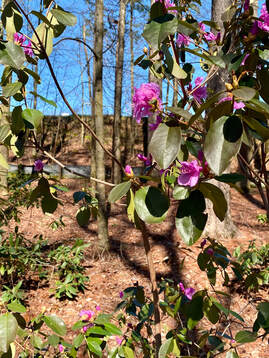
Planted in 2010, the Rhododendron Garden is located along the path to the Children’s Garden across the walking path from the running pine and bog. It features a variety of this diverse family - woody plants of the heath family. They are best known for many clusters of large flowers.
Rhododendrons prefer environments that are neither too hot nor too cold, such as Zones 5-8. They need a certain amount of chilling to develop strong flower buds. They also require an adequate amount of water. They bloom from the late winter through early summer. With thousands of species, there are rhododendrons for almost every Southern landscape.
This garden has also served as a memorial garden for years, featuring many commemorative trees, shrubs and rhododendrons. Signs at the base of each plant identify the honorees and donors.
CURATOR(S): Janice Taylor
Rhododendrons prefer environments that are neither too hot nor too cold, such as Zones 5-8. They need a certain amount of chilling to develop strong flower buds. They also require an adequate amount of water. They bloom from the late winter through early summer. With thousands of species, there are rhododendrons for almost every Southern landscape.
This garden has also served as a memorial garden for years, featuring many commemorative trees, shrubs and rhododendrons. Signs at the base of each plant identify the honorees and donors.
CURATOR(S): Janice Taylor
Shade Garden
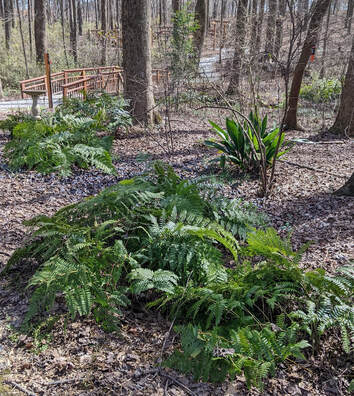
The Shade Garden is located across from the Children’s Garden, next to the Fern Garden. It was cleared and planting began in 2008. This garden is home to a stunning array of trees, shrubs, flowers, ferns, hostas and natives. These provide a vibrant year-round display of foliage and flowers in a wide variety of colors, patterns, shapes and sizes.
The canopy of trees includes Japanese maples, sweet bay and Southern magnolias, dwarf umbrella tree, American beech and dogwoods. Shrubs include Cleyera Japonica, Illicium, hydrangeas, sweet Osmanthus, American strawberry bush and azaleas. Flowers include water iris, downy lobelia, daffodils and spiderwort. Wild ginger, Trillium and switch cane are among the natives found along the peaceful trails through this garden.
During the past few years and impromptu Fairy Garden has been added by garden visitors of all ages. Gnome and fairy houses, small characters and whimsical decorations come, go and are re-arranged as the wee people and their garden friends enjoy each other’s company.
CURATOR(S): Vivian Davis, Jeannine Brownsberger
The canopy of trees includes Japanese maples, sweet bay and Southern magnolias, dwarf umbrella tree, American beech and dogwoods. Shrubs include Cleyera Japonica, Illicium, hydrangeas, sweet Osmanthus, American strawberry bush and azaleas. Flowers include water iris, downy lobelia, daffodils and spiderwort. Wild ginger, Trillium and switch cane are among the natives found along the peaceful trails through this garden.
During the past few years and impromptu Fairy Garden has been added by garden visitors of all ages. Gnome and fairy houses, small characters and whimsical decorations come, go and are re-arranged as the wee people and their garden friends enjoy each other’s company.
CURATOR(S): Vivian Davis, Jeannine Brownsberger
The Spirit Garden
The Spirit Garden is our newest addition to the garden. During the pandemic of 2020, HCBG was not able to hold the Annual Plant Sale. Having already purchased plants and with no way to conduct the sale, the Friends of the Garden took and planted thirty of the native azalea bushes along the path from the entrance to the Anne King Garden and created the Spirit Garden to remember that difficult time for the country.
This garden is dedicated to "Hart County 's Front Line Heroes and the intrepid community that supports them."
This garden is dedicated to "Hart County 's Front Line Heroes and the intrepid community that supports them."
Sun Perennial Garden
The Sun Perennial Garden, planted in 2010, is located in the sunniest area of garden near the front entrance. The garden does not focus solely on perennials but is more of a “mixed border” garden including small trees and shrubs as a backdrop for perennials and annuals. The garden has four seasons of interest.
Also, many of the plants selected not only have beautiful blooms, but are fragrant and attract birds, bees and butterflies. Hummingbirds frequent the garden and love the many cultivars of perennial salvias and other nectar rich plants. These plants are all worthy of consideration by the average homeowner/gardener for their own Zone 8 gardens.
Most of the plants are “water wise,” low susceptibility to pests, and maintenance free except for some deadheading, which promotes more new blooms. Most of the selections will not become large and crowd a typical suburban garden.
CURATORS: Robert Meaders, Barbara Camp, Kate Kirby, Jim & Debbie Ray
Also, many of the plants selected not only have beautiful blooms, but are fragrant and attract birds, bees and butterflies. Hummingbirds frequent the garden and love the many cultivars of perennial salvias and other nectar rich plants. These plants are all worthy of consideration by the average homeowner/gardener for their own Zone 8 gardens.
Most of the plants are “water wise,” low susceptibility to pests, and maintenance free except for some deadheading, which promotes more new blooms. Most of the selections will not become large and crowd a typical suburban garden.
CURATORS: Robert Meaders, Barbara Camp, Kate Kirby, Jim & Debbie Ray
Swale Garden
The Swale Garden, designated, freshly cleared and planted in 2021, is located between the Conifer Garden and the Berm. It is the result of water run-off from the recreation fields-garden parking area. Here you will find many trees and plants that like their “feet wet.” The water level rises and falls depending on the seasons.
Trees in the Swale include river birch, cypress, weeping willow, black pussy willow and black cherry. Featured water loving plants include rushes, arrow root, swamp sunflower, inland sea oats, bonesets, frost asters, Canada golden rod, crimson-eyed rose mallow, seed box and cup plant.
The Berm offers a nice walking path along the Swale shoreline; several benches and memorial trees can be found there. The seasonal song of frogs often fills the air. Butterflies abound and mockingbirds sing from the holly trees at the edge of the Conifer Garden. The Swale can also be enjoyed from the Conifer Garden, on the seating wall near the wind sculpture.
CURATOR(S): Woody Eakin
Trees in the Swale include river birch, cypress, weeping willow, black pussy willow and black cherry. Featured water loving plants include rushes, arrow root, swamp sunflower, inland sea oats, bonesets, frost asters, Canada golden rod, crimson-eyed rose mallow, seed box and cup plant.
The Berm offers a nice walking path along the Swale shoreline; several benches and memorial trees can be found there. The seasonal song of frogs often fills the air. Butterflies abound and mockingbirds sing from the holly trees at the edge of the Conifer Garden. The Swale can also be enjoyed from the Conifer Garden, on the seating wall near the wind sculpture.
CURATOR(S): Woody Eakin
Click below for more information regarding the formation of the garden.
| history-of-the-garden.html | |
| File Size: | 249 kb |
| File Type: | html |
| Reimbursement Form | |
| File Size: | 412 kb |
| File Type: | |
